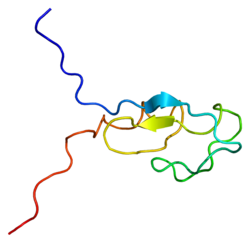| PRKCG |
|---|
 |
| Available structures |
|---|
| PDB | Ortholog search: PDBe RCSB |
|---|
| List of PDB id codes |
|---|
2E73, 2UZP |
|
|
| Identifiers |
|---|
| Aliases | PRKCG, PKC-gamma, PKCC, PKCG, SCA14, protein kinase C gamma, PKCI(3), PKCgamma |
|---|
| External IDs | OMIM: 176980; MGI: 97597; HomoloGene: 20602; GeneCards: PRKCG; OMA:PRKCG - orthologs |
|---|
| Gene location (Human) |
|---|
 | | Chr. | Chromosome 19 (human)[1] |
|---|
| | Band | 19q13.42 | Start | 53,879,190 bp[1] |
|---|
| End | 53,907,652 bp[1] |
|---|
|
| Gene location (Mouse) |
|---|
 | | Chr. | Chromosome 7 (mouse)[2] |
|---|
| | Band | 7 A1|7 1.93 cM | Start | 3,337,704 bp[2] |
|---|
| End | 3,379,615 bp[2] |
|---|
|
| RNA expression pattern |
|---|
| Bgee | | Human | Mouse (ortholog) |
|---|
| Top expressed in | - right frontal lobe
- nucleus accumbens
- prefrontal cortex
- amygdala
- Brodmann area 9
- cingulate gyrus
- anterior cingulate cortex
- caudate nucleus
- right hemisphere of cerebellum
- hippocampus proper
|
| | Top expressed in | - hippocampus proper
- primary visual cortex
- dentate gyrus of hippocampal formation granule cell
- cerebellum
- cerebellar cortex
- Cortex of frontal lobe
- superior frontal gyrus
- striatum of neuraxis
- hypothalamus
- olfactory bulb
|
| | More reference expression data |
|
|---|
| BioGPS |  | | More reference expression data |
|
|---|
|
| Gene ontology |
|---|
| Molecular function | - transferase activity
- protein kinase activity
- nucleotide binding
- protein kinase C activity
- zinc ion binding
- metal ion binding
- kinase activity
- protein serine/threonine kinase activity
- protein serine/threonine/tyrosine kinase activity
- ATP binding
- calcium-dependent protein kinase C activity
| | Cellular component | - cytoplasm
- synaptic membrane
- cytosol
- cell projection
- membrane
- cell-cell junction
- plasma membrane
- synapse
- intracellular anatomical structure
- cell junction
- dendrite
- perinuclear region of cytoplasm
- neuron projection
- nucleus
- postsynaptic density
- calyx of Held
- presynaptic cytosol
- postsynaptic cytosol
| | Biological process | - negative regulation of neuron apoptotic process
- intracellular signal transduction
- phosphorylation
- negative regulation of protein catabolic process
- rhythmic process
- regulation of response to food
- platelet activation
- chemosensory behavior
- negative regulation of protein ubiquitination
- protein phosphorylation
- response to morphine
- positive regulation of mismatch repair
- response to pain
- regulation of circadian rhythm
- peptidyl-serine phosphorylation
- learning or memory
- protein autophosphorylation
- negative regulation of proteasomal protein catabolic process
- regulation of phagocytosis
- innervation
- chemical synaptic transmission
- response to psychosocial stress
- presynaptic modulation of chemical synaptic transmission
- regulation of synaptic vesicle exocytosis
| | Sources:Amigo / QuickGO |
|
|
| Wikidata |
| View/Edit Human | View/Edit Mouse |
|

 1tbn: NMR STRUCTURE OF A PROTEIN KINASE C-G PHORBOL-BINDING DOMAIN, MINIMIZED AVERAGE STRUCTURE
1tbn: NMR STRUCTURE OF A PROTEIN KINASE C-G PHORBOL-BINDING DOMAIN, MINIMIZED AVERAGE STRUCTURE 1tbo: NMR STRUCTURE OF A PROTEIN KINASE C-G PHORBOL-BINDING DOMAIN, 30 STRUCTURES
1tbo: NMR STRUCTURE OF A PROTEIN KINASE C-G PHORBOL-BINDING DOMAIN, 30 STRUCTURES 2uzp: CRYSTAL STRUCTURE OF THE C2 DOMAIN OF HUMAN PROTEIN KINASE C GAMMA.
2uzp: CRYSTAL STRUCTURE OF THE C2 DOMAIN OF HUMAN PROTEIN KINASE C GAMMA.






















